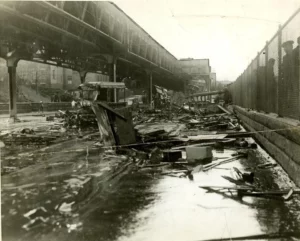
By: Hannah Brevoort
The morning of January 15, 1919 dawned bright and warm in Boston. The temperature was almost 40 degrees, and there was no snow despite it being midwinter. It was a Wednesday so many of the immigrants living in the North End neighborhood were at work, including some at the local Purity Distilling Company facility on Commercial Street. That facility included several 50 foot tall molasses storage tanks capable of holding over 2 million gallons of molasses each. These colossal tanks were located in an open square where many workers gathered for lunch.
At approximately 12:30 p.m., a roaring noise shattered the calm. With little warning, one of the storage tanks collapsed, unleashing its 2.3 million gallons of sticky molasses on the surrounding area. The wave of molasses, reaching 15 to 25 feet high and 35 miles per hour at one point, destroyed everything in its path. The molasses also surged over people and animals, trapping them in thick goo that resisted even their most frantic efforts to escape. Ultimately 21 people were killed and over 100 others injured.
Who was at fault for this tragedy? The courts ultimately placed blame for the disaster on the United States Industrial Alcohol Company, the parent company of the Purity Distilling Company, saying that they had repeatedly ignored signs that the tank was in need of repair. It took almost 100 years, though, to fully understand what had made molasses so deadly that day. In 2016, scientists from the American Physical Society argued that the disaster was more fatal because it occurred in the winter. The molasses escaped from the tank in a warm wave, allowing it to surge high and fast, but the winter air caused it to cool and thicken over time. People hit by the wave became increasingly trapped by the cooling molasses, explaining why about half of the victims died while waiting for rescue.
On hot summer days some Bostonians claim the North End still smells of molasses Learn more about the Great Molasses Flood of 1919:
https://www.nytimes.com/2016/11/26/science/boston-molasses-flood-science.html?&_r=0 https://www.scientificamerican.com/article/molasses-flood-physics-science/ The primary source article linked below was published by the New York Times a day after the disaster. How is this similar to, and different from, how the news covers disasters now? Find an article about a recent natural disaster or accident to compare and contrast. http://query.nytimes.com/mem/archive-free/pdf?_r=1&res=9B04E4D71339E13ABC4E52DFB7668382609EDE&oref=slogin Research question (9th-12th grade):